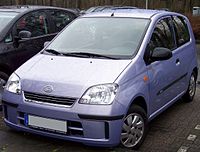Daihatsu
Daihatsu (ダイハツ) is a Japanese car manufacturer, especially segments A and B.
HISTORY
The origin of Daihatsu dates back to the internal combustion motors Hatsudoki Seizo Co., founded in Osaka in 1907, which produced its first 3 -wheeled vehicle in 1930 and in 1951 it adopted the name Daihatsu Motor Co. Participation From Toyota dates from 1967 and in 1999 he made Daihatsu his subsidiary.
- 1907: It is founded as Hatsudoki Seizo Co., Ltd.
- 1951: Change of name: Daihatsu Motor Co., Ltd.
- 1967: Cooperation with the Toyota Motor Corporation begins.
- 1977: Daihatsu launches the Charade market.
- 1988: Daihatsu USA launches Rocky.
- 1992: Daihatsu USA closes in February.
- 1995: Daihatsu launches its mythical Charade GTti, with its 1.0 engine of 12 valves, double cam tree, a 0.75 bar turbo capable of taking it to the 190Km/h.
- 1999: He becomes a subsidiary of the Toyota Motor Corporation.
- 2005: The Daihatsu Delta Truck is assembled in Sofasa, Colombia.
- 2010: The assembly line is removed from SOFASA facilities, and is now owned jointly by the Mitsui and Praco-DIDACOL group..
News
In 2004, Daihatsu built 965,295 automobiles (including commercial vehicles), an increase of 7.6% from the 897,116 in the previous year. 90% of Daihatsu's production corresponds to mini cars with less than 660 cc displacement destined for its domestic market and other Asian countries, taking advantage of the fact that this category has preferential tax treatment in Japan. It also makes some light commercial models.
Daihatsu is owned by the Toyota Group (which owns 51.6% of the shares), the world's largest manufacturer. It specializes in the production of small-format, high-performance and very low-emission cars. In alliance with Toyota, Daihatsu assembles cars in Colombia, China, Indonesia, Malaysia, Vietnam, Pakistan and Venezuela. It also researches and develops alternative technologies to the conventional engine. It has presented HVS (Hybrid Sports Car) prototypes based on the hybrid technology of combining an electric motor with an internal combustion engine.
Daihatsu's best-known models outside its home market are the Cuore/Move/Mira (segment A), the Charade and Sirion (segment B), the Copen convertible and the Terios mini SUV.
At the end of 2004 Daihatsu withdrew from the Chilean market after selling only 14 units of its Terios SUV. This withdrawal was emblematic since the brand enjoyed a sales boom in the 80s, being remembered to this day as reliable and economical.
On March 31, 2005 Toyota announced the withdrawal of Daihatsu from the Australian market, after sales declined sharply. These are down a third so far in 2005, from 816 to just 541 vehicles, despite Australia's new car market growing by 7%. Daihatsu stopped selling its models in March 2006, after having been in the Australian market for almost forty years.
In 2006, the Terios SUV returned to the Chilean market, this time at the hands of Toyota, which bought the representation from the former distributor and has since sold Daihatsu vehicles at its own dealerships.
In 2007 Daihatsu manufactured 856,200 vehicles, 21.1% less than in 2006. Of this total, 711,600 were passenger cars and 144,600 commercial vehicles.
That same year Daihatsu returned to Chile at the hands of Toyota to market the Terios Wild, Terios Advantage, Copen, Sirion and Cuore models, however only the Terios arrived in the South American country in its 2 variants and the Copen, which unless One year after it was on the market, it was withdrawn from the market.
In 2016 Toyota purchases the remaining assets of Daihatsu and thus makes Daihatsu a wholly owned subsidiary.
Car models
Plants
- Ikeda (Osaka prefecture), also home matrix.
- Ryuo (Shiga prefecture)
- Tada (hyogo prefecture)
- Oyamazaki (Kyoto prefecture)
- Cumaná, Estado Sucre, Venezuela (only the Terios van is assembled and shares the plant with Toyota).
Contenido relacionado
Charlie Bell (businessman)
Charles henry dow
Quality
